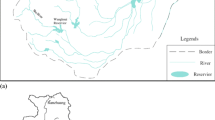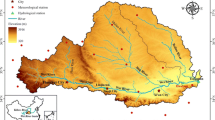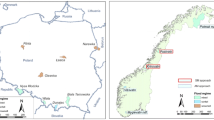Abstract
The assumption of stationarity in the flood time series is the basis for flood design and forecasting. Therefore, identification of the non-stationarity of flood series and the underlying causes is necessary for flood risk and water resources management. The Wei River Basin (WRB) of China was selected as the case study. Nonstationary flood behavior was examined comprehensively in terms of trends and the mean and variance change point. Then, the implications of the nonstationary flood series were explored. Furthermore, the impacts of antecedent precipitation, El Niño Southern Oscillation/Pacific Decadal Oscillation and vegetation coverage on floods were investigated. The results indicated following: (1) There is a non-significant delay in the timing of the annual maximum flood peak and seasonal floods across the basin; (2) the assumption of stationarity in the flood series is invalid, with significant downward trends and change points identified; (3) bias arising from the variance change point is much more significant than that of the mean change point in estimating floods; and (4) changing climate and human activities are jointly responsible for nonstationary floods in the WRB. These findings provide new insights into nonstationary flood behavior by emphasizing the importance of identifying the potential variance change points in the flood series, which is important for flood mitigation and water resources management.








Similar content being viewed by others
References
Bai P, Liu X, Liang K et al (2016) Investigation of changes in the annual maximum flood in the Yellow River basin, China. Quat Int 392(392):168–177
Bernaola-Galván IPC et al (2001) Scale invariance in the nonstation-arty of human heart rate. Phys Rev Lett 87(16):160815
Chen J, Gupta AK (1997) Testing and locating variance change points with application to stock prices. Publ Am Stat Assoc 92(438):739–747
Chen T, de Jeu RAM, Liu YY et al (2014) Using satellite based soil moisture to quantify the water driven variability in NDVI: a case study over mainland Australia. Remote Sens Environ 140(140):330–338
Guo A, Chang J, Wang Y et al (2018) Flood risk analysis for flood control and sediment transportation in sandy regions: a case study in the loess plateau, China. J Hydrol 560:39–55
Hamed KH, Rao AR (1998) A modified Mann-Kendall trend test for autocorrelated data. J Hydrol 204(1–4):182–196
Han S, Coulibaly P (2017) Bayesian flood forecasting methods: a review. J Hydrol 551:340–351
Huang S, Chang J, Huang Q et al (2014) Spatio-temporal changes and frequency analysis of drought in the Wei River basin, China. Water Resour Manag 28(10):3095–3110
Huang S, Huang Q, Chang J et al (2015) Drought structure based on a nonparametric multivariate standardized drought index across the yellow river basin, China. J Hydrol 530:127–136
Huang S, Huang Q, Leng G et al (2017) Variations in annual water-energy balance and their correlations with vegetation and soil moisture dynamics: a case study in the Wei River basin, China. J Hydrol 546:515–525
Hudgins LH (1993) Wavelet transforms and atmospheric turbulence. Phys Rev Lett 71:3279–3282
Ishak EH, Rahman A, Westra S et al (2013) Evaluating the non-stationarity of Australian annual maximum flood. J Hydrol 494(12):134–145
Kendall MG (1955) Rank correlation methods. Griffin, London
Li J, Liu X, Chen F (2015) Evaluation of nonstationarity in annual maximum flood series and the associations with large-scale climate patterns and human activities. Water Resour Manag 29(5):1653–1668
Liu S, Huang S, Huang Q et al (2017) Identification of the non-stationarity of extreme precipitation events and correlations with large-scale ocean-atmospheric circulation patterns: a case study in the Wei River basin, China. J Hydrol 548:184–195
Liu S, Huang S, Xie Y et al (2018) Spatial-temporal changes of maximum and minimum temperatures in the Wei River basin, China: changing patterns, causes and implications. Atmos Res 204:1–11
Mann HB (1945) Nonparametric tests against trend. Econometrica 13:245–259
Mediero L, Santillán D, Garrote L et al (2014) Detection and attribution of trends in magnitude, frequency and timing of floods in Spain. J Hydrol 517(1):1072–1088
Nosek K (2010) Schwarz information criterion based tests for a change-point in regression models. Stat Pap 51(4):915–929
Nourani V, Ghasemzade M, Mehr AD et al (2018) Investigating the effect of hydroclimatological variables on Urmia Lake water level using wavelet coherence measure. J Water Clim Chang 2018:jwc2018261
Ogie RI, Holderness T, Dunn S et al (2018) Assessing the vulnerability of hydrological infrastructure to flood damage in coastal cities of developing nations. Comput Environ Urban Syst 68:97–109
Petrow T, Merz B (2009) Trends in flood magnitude, frequency and seasonality in Germany in the period 1951-2002. J Hydrol 371(1):129–141
Salvadori, Neila (2013) Evaluation of non-stationarity in annual maximum flood series of moderately impaired watersheds in the upper Midwest and Northeastern United States, Master's Thesis, Michigan Technological University
Torrence C, Compo GP (1998) A practical guide to wavelet analysis. Bull Am Meteorol Soc 79:61–78
Tu X, Chen X (2010) Characteristics variability study of regional river runoff time series based on change point recognition. J Ntrl Resource 25(11):1930–1937
Wang D, Hagen SC, Alizad K (2013) Climate change impact and uncertainty analysis of extreme rainfall events in the Apalachicola river basin, Florida. J Hydrol 480(4):125–135
Zhang H, Zhang S, Li J et al (2017) Detection and diagnosis of the change points in variance of hydrological time series in the Weihe River basin based on TFPW-DT-ICSS method. J N Ch Univ Water Resource Elect Power (Ntrl Sci Ed) 38(4):47–53
Acknowledgements
This research was supported by the National Natural Science Foundation of China (51709221), the Planning Project of Science and Technology of Water Resources of Shaanxi (2015slkj-27, 2017slkj-19), Key laboratory research projects of education department of Shaanxi province (17JS104), and China Scholarship Council (201708610118).
Author information
Authors and Affiliations
Corresponding author
Ethics declarations
Conflict of Interest
None.
Additional information
Publisher’s Note
Springer Nature remains neutral with regard to jurisdictional claims in published maps and institutional affiliations.
Rights and permissions
About this article
Cite this article
Liu, S., Huang, S., Xie, Y. et al. Identification of the Non-stationarity of Floods: Changing Patterns, Causes, and Implications. Water Resour Manage 33, 939–953 (2019). https://doi.org/10.1007/s11269-018-2150-y
Received:
Accepted:
Published:
Issue Date:
DOI: https://doi.org/10.1007/s11269-018-2150-y




